brake AUDI S8 2008 Repair Manual
[x] Cancel search | Manufacturer: AUDI, Model Year: 2008, Model line: S8, Model: AUDI S8 2008Pages: 404, PDF Size: 52.7 MB
Page 319 of 404
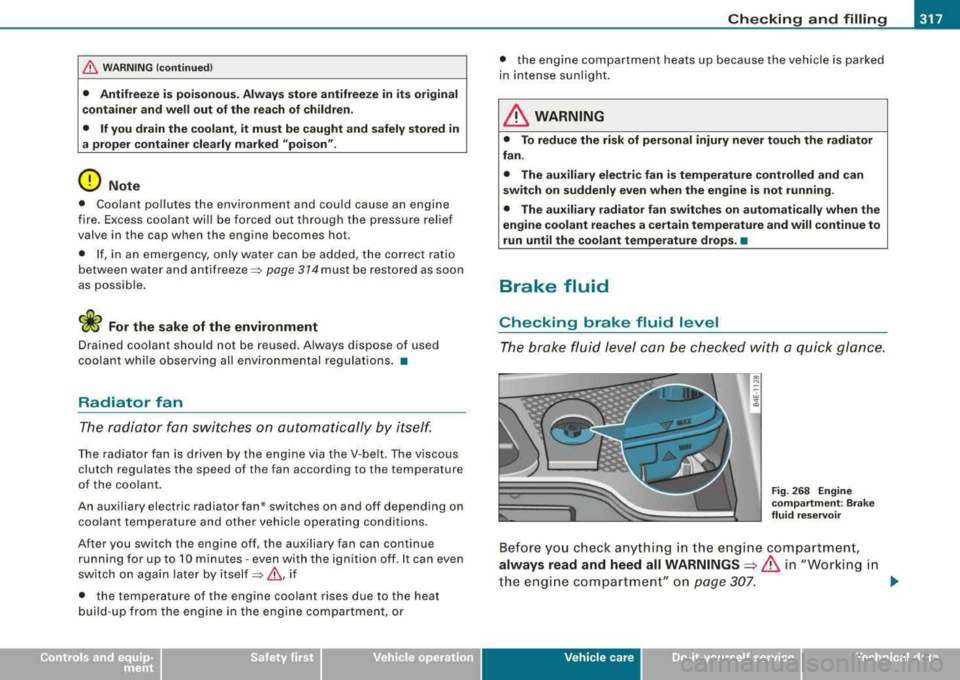
Checking and filling -_______________________________ =..:..:..::...::.:..;~:.....:...;_.:..:..,__--=--.J
fl::. WARNING (continued )
• Antifr eez e is po isonous. Always stor e antifreeze in it s origin al
c ontainer and well out of the re ach of ch ildren .
• If you drain the coolant , it must be caught and saf ely stored in
a prop er co ntainer cle arly m arked "poi son ".
0 Note
• Coolant po llutes the environment and cou ld cause an engine
fire. Excess coolant will be forced out through the pressure relief
valve in the cap when the engine becomes hot.
• I f, in an emergency, only wa ter can be added, the correct ratio
between water and
antifreeze => page 314 must be restored as soon
as possib le .
W For the sake of the environment
Drained coolant should not be reused . A lways dispose of used
coolant while observing all environmental regulations . •
Radiator fan
The radiator fan switches on automatically by i tself .
The radiator fan is driven by the engine via the V-be lt. The viscous
clutch regulates the speed of the fan according to the temperature
of the coo lan t.
An auxiliary electric radiator fan * switches on and off depending on
coolant temperature and other vehic le opera ting condi tions.
After you switch the engine off , the auxiliary fan can continue
running for up to 10 minutes -even with the ignition off. It can even
switch on again later by
itself =>& , if
• the temperature of the engine coo lant rises due to the heat
bu ild -up fro m the engine in the engine c ompar tment , or •
the engine compartment heats up because the vehicle is parked
in intense sunlight .
& WARNING
• To reduce the ri sk of per sonal injury never tou ch the radiator
fan .
• The au xiliary elect ric fan i s te mperature controlled and can
switch on suddenly e ven when the engine is not running .
• The au xiliary radiato r fan switche s on auto matically when th e
eng ine coolant reache s a certain temperature and will continue to
run until the coo lant temperat ure drop s. •
Brake fluid
Checking brake fluid level
T he brake fluid level can be checked with a quick glance.
-w ;:;
Fig . 26 8 Engin e
c o mp artm ent: B ra ke
fluid r eservoir
Before you check anyth ing in the e ngine compartmen t,
always read and heed all WARNINGS ~ & in "Working in
t h e engi ne compartment " on
page 307. _,,,
Vehicle care I I irechnical data
Page 320 of 404
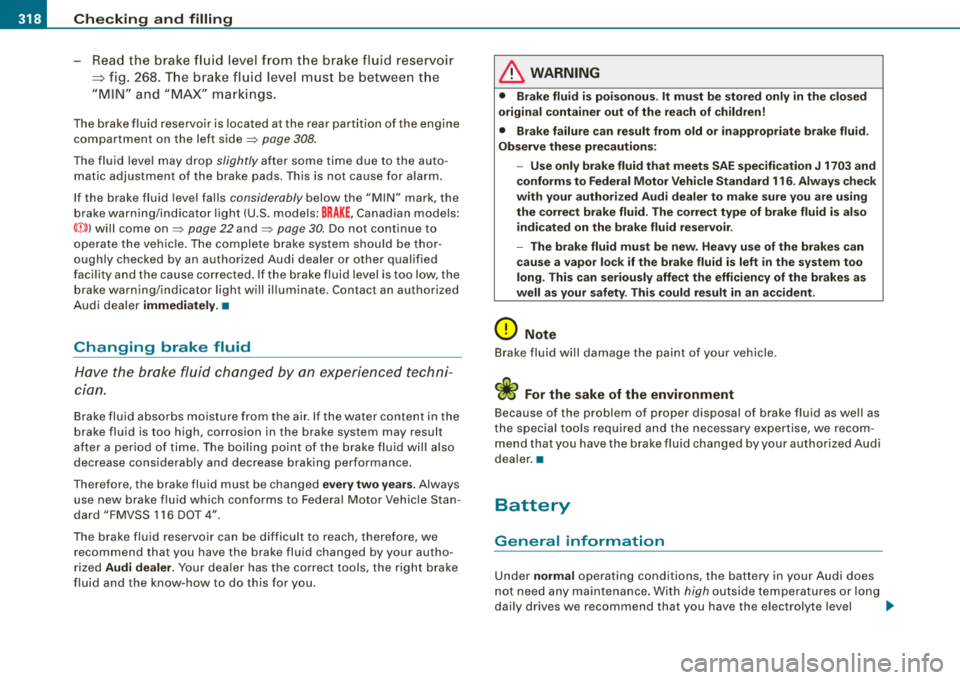
___ C_ h_e _c _ k_ i_ n ~g~ a_ n_ d_ f_ i_ll _in _g~--------------------------------------------
-Read the brake fluid level from the brake fluid reservoir
=> fig. 268. The brake fluid level must be between the
"MIN" and "MAX" markings.
The brake fluid reservoir is located at the rear partition of the engine
compartment on the left
side~ page 308.
The fluid level may drop slightly after some time due to the auto
matic adjustment of the brake pads. This is not cause for alarm.
If the brake fluid level falls considerably below the "MIN" mark, the
brake warning/indicator light (U.S. models:
BRAKE , Canadian models:
«D>l will come on~ page 22 and~ page 30. Do not continue to
operate the vehicle. The complete brake system should be thor
oughly checked by an authorized Audi dealer or other qualified
facility and the cause corrected. If the brake fluid level is too low, the
brake warning/indicator light will illuminate. Contact an authorized
Audi dealer
immediately. •
Changing brake fluid
Have the brake fluid changed by an experienced techni
cian.
Brake fluid absorbs moisture from the air. If the water content in the
brake fluid is too high, corrosion in the brake system may result
after a period of time. The boiling point of the brake fluid will also
decrease considerably and decrease braking performance.
Therefore, the brake fluid must be changed
every two years. Always
use new brake fluid which conforms to Federal Motor Vehicle Stan
dard "FMVSS 116 DOT 4".
The brake fluid reservoir can be difficult to reach, therefore, we
recommend that you have the brake fluid changed by your autho
rized
Audi dealer. Your dealer has the correct tools, the right brake
fluid and the know-how to do this for you.
& WARNING
• Brake fluid is poisonous . It must be stored only in the closed
original container out of the reach of children!
• Brake failure can result from old or inappropriate brake fluid .
Observe these precautions:
-Use only brake fluid that meets SAE specification J 1703 and
conforms to Federal Motor Vehicle Standard 116. Always check
with your authorized Audi dealer to make sure you are using
the correct brake fluid. The correct type of brake fluid is also indicated on the brake fluid reservoir .
- The brake fluid must be new. Heavy use of the brakes can
cause a vapor lock if the brake fluid is left in the system too
long. This can seriously affect the efficiency of the brakes as
well as your safety . This could result in an accident .
0 Note
Brake fluid will damage the paint of your vehicle .
<£> For the sake of the environment
Because of the problem of proper disposal of brake fluid as well as
the special tools required and the necessary expertise, we recom
mend that you have the brake fluid changed by your authorized Audi
dealer. •
Battery
General information
Under normal operating conditions, the battery in your Audi does
not need any maintenance. With high outside temperatures or long
daily drives we recommend that you have the electrolyte level .,,_
Page 326 of 404
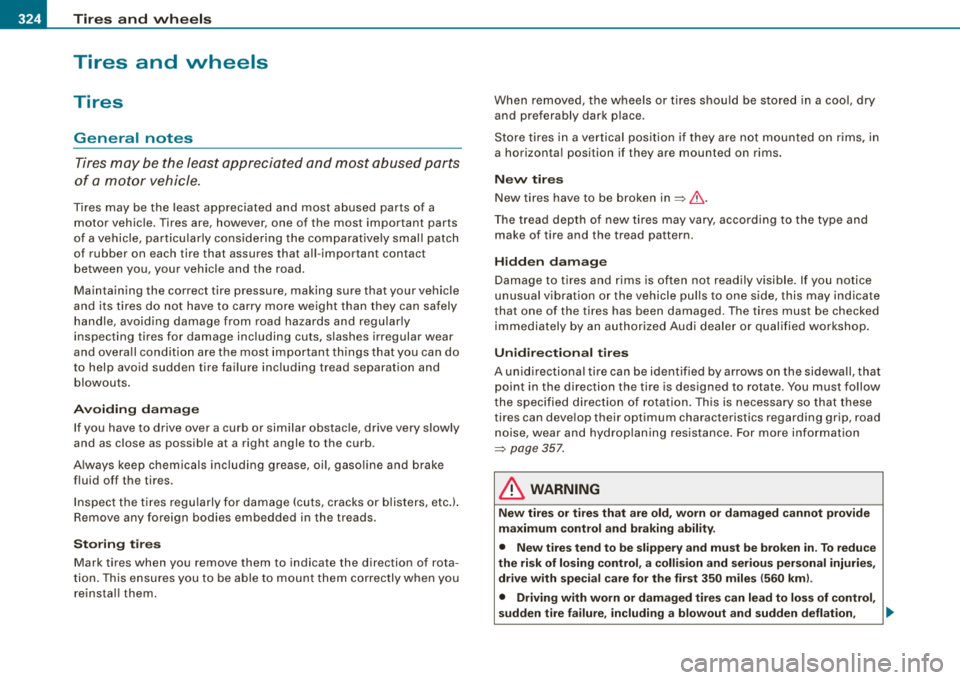
lll'ft __ T_ ir_e _s_ a_n_ d_ w_ h
_ e_e_ l_ s _______________________________________________ _
Tires and wheels
Tires
General notes
Tires may be the least appreciated and most abused parts
of a motor vehicle.
Tires may be the least appreciated and most abused parts of a
motor vehicle. Tires are, however, one of the most important parts
of a vehicle, particu lar ly considering the comparatively smal l patch
of rubber on each tire that assures that all -important contact
between you, your vehic le and the road.
Maintaining the correct tire pressure, making sure that your vehicle
and its t ires do not have to carry more we ight than they can safely
handle, avoiding damage from road hazards and regularly
inspecting tires for damage inc luding cuts, slashes irregular wear
and overa ll condition are the most important things that you can do
to help avoid sudden tire failure inc luding tread separation and
blowouts.
Av oidin g dam age
If you have to drive over a curb or similar obstac le, drive very slowly
and as close as possib le at a right angle to the curb .
A lways keep chem ica ls including grease, oi l, gaso line and brake
flu id off the ti res.
Inspect t he t ires regu larly fo r damage (cuts, cracks or b listers, etc .l.
Remove any foreign bodies embedded in the treads .
Storing tire s
Mark tires when you remove them to indicate the direction of rota
tion . This ensures you to be able to moun t them correctly w hen you
reinstal l them. When removed, the wheels or tires shou
ld be stored in a coo l, dry
and preferably dark place .
S tore tires in a vert ical pos it ion if they are not mounted on r ims, in
a horizonta l position if they are mounted on rims.
New tire s
New tires have to be broken in=> &.
The tread depth of new ti res may vary, according to the type and
make of tire and the tread pattern .
Hidden dam age
Damage to tires and rims is often not readily visible . If you notice
unusual vibration or the vehicle pu lls to one side, this may ind ica te
that one of the tires has been damaged . The tires must be checked
immediately by an authorized Audi dealer or qual ified workshop .
Unidir ec tiona l tir es
A unid irec tional tire can be identified by arrows on the sidewa ll, that
point in the direction the tire is designed to rotate. You must fo llow
t he specified directio n of rotation . Th is is necessary so that t hese
tires can deve lop their optimum characteristics regarding grip, road
noise, wear and hydrop laning resistance . For more information
=> page 357.
& WARNING
New t ires or tire s th at a re old , worn or d am aged cann ot pro vide
maximum control and braking ability.
• New tire s tend to be slipper y and mu st be bro ken in . To redu ce
the risk of lo sin g con tro l, a collision and seriou s per sonal injurie s,
dri ve w ith spe cial care f or the fi rst 350 mile s (560 km l.
• Driving wi th worn or damaged tir es can l ead to lo ss of control ,
sudd en tire f ailure , inc ludi ng a blowout and sudden defl atio n, .,_
Page 327 of 404
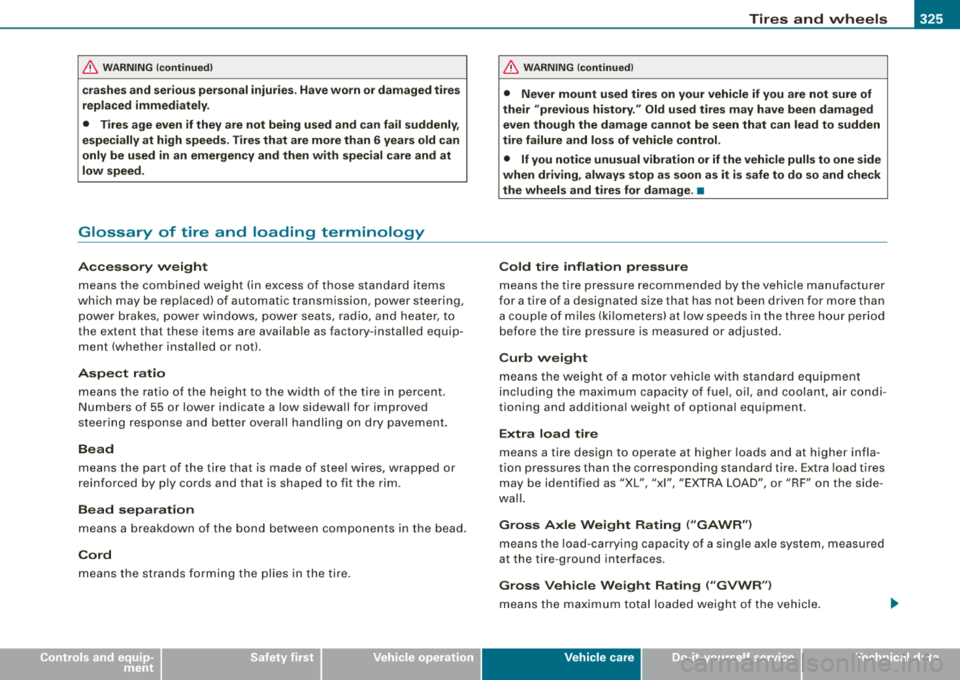
Tires and wheels -
----------------
•
& WARNING (continued)
crashes and serious personal injuries . Have worn or damaged tires
replaced immediately.
• Tires age even if they are not being used and can fail suddenly,
especially at high speeds. Tires that are more than 6 years old can
only be used in an emergency and then with special care and at
low speed.
Glossary of tire and loading terminology
Accessory weight
means the combined weight (in excess of those standard items
which may be replaced) of automatic transmission, power steering,
power brakes, power windows, power seats, radio, and heater, to
the extent that these items are available as factory-installed equip
ment (whether installed or not).
Aspect ratio means the ratio of the height to the width of the tire in percent.
Numb ers of 55 or lower indicate a low sidewall for improved
steering response and better overall handling on dry pavement.
Bead
means the part of the tire that is made of steel wires, wrapped or
reinforced by ply cords and that is shaped to fit the rim.
Bead separation
means a breakdown of the bond between components in the bead.
Cord
means the strands forming the plies in the tire.
& WARNING (continued)
• Never mount used tires on your vehicle if you are not sure of
their
"previous history." Old used tires may have been damaged
even though the damage cannot be seen that can lead to sudden
tire failure and loss of vehicle control.
• If you notice unusual vibration or if the vehicle pulls to one side
when driving, always stop as soon as it is safe to do so and check
the wheels and tires for damage.
•
Cold tire inflation pressure
means the tire pressure recommended by the vehicle manufacturer
for a tire of a designated size that has not been driven for more than
a couple of miles (kilometers) at low speeds in the three hour period
before the tire pressure is measured or adjusted.
Curb weight
means the weight of a motor vehicle with standard equipment
including the maximum capacity of fuel, oil, and coolant, air condi
tioning and additional weight of optional equipment.
Extra load tire
means a tire design to operate at higher loads and at higher infla
tion pressures than the corresponding standard tire. Extra load tires
may be identified as
"XL", "xi", "EXTRA LOAD", or "RF" on the side
wall.
Gross Axle Weight Rating
("GAWR")
means the load-carrying capacity of a single axle system, measured
at the tire -ground interfaces.
Gross Vehicle Weight Rating
( " GVWR")
means the maximum total loaded weight of the vehicle.
Vehicle care
Page 328 of 404
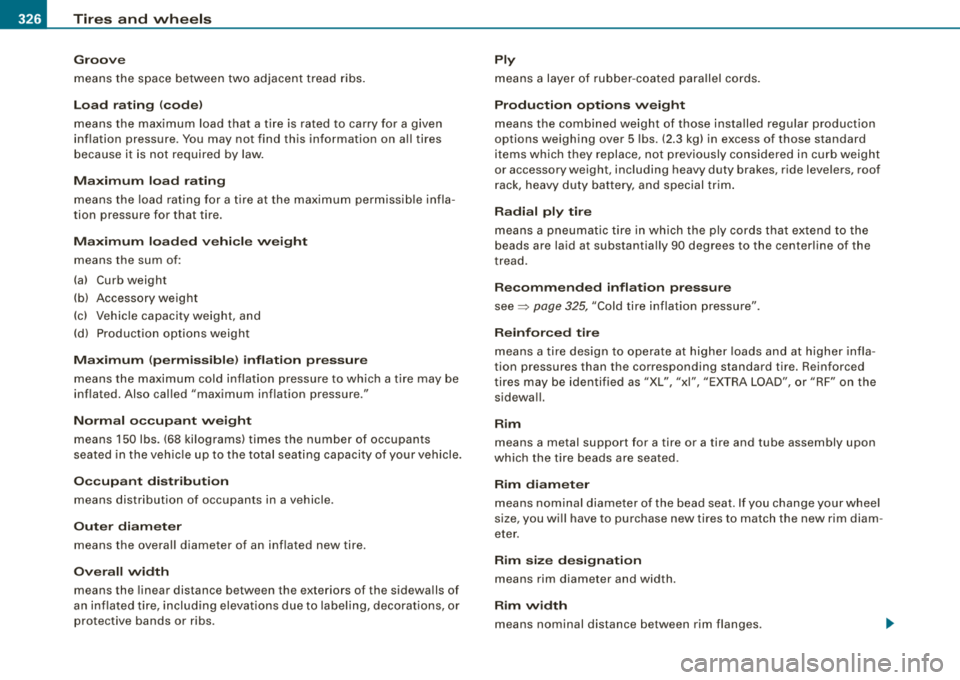
_L--_T_ ir_e_ s_ a_ n_d _ w_ h_ e_e _l_s _________________________________________________ _
Groove
means the space between two adjacent tread ribs.
L oa d r atin g (code)
means t he m aximum load that a t ire is rated to carry for a given
inf lation pressure . You may not find this information on a ll tires
because it is not required by law.
M ax imum l oad r ating
means t he load rating for a tire a t the maximum permissib le infla
tion pressure for that tire.
Maximum l oaded v ehi cle wei ght
means the sum of:
(a) Curb weight
(b) Accessory weight
(c) Vehicle capaci ty weight, and
(d) Product ion options weight
M ax imum (p er mis sibl e) infl ati on pr essure
means the maximum cold i nflation pressure to wh ic h a t ire may be
inflated. Also cal led "maximum inflation pressure."
Normal occ upant we ight
means 150 lbs. (68 ki lograms) times the number of occupants
seated in the veh ic le up to the total seating capacity of your vehicle.
Oc cupant distributi on
means distribution of occupants in a vehicle .
Outer di ameter
means the overal l diameter of an inf lated new tire.
O verall width
means the linear distance between the exteriors of the sidewa lls of
an infla ted t ire, includ ing elevat ions due to labe ling, decorat ions, or
protective bands or ribs .
Ply
means a layer of rubber -coated para llel cords.
P rodu cti on opt ion s we ig ht
means the co mbined weight of those insta lled regular product ion
options weighing over 5 lbs. (2.3 kg) in excess of those standard
items which t hey replace, not previously considered in curb weight
or accessory weight, inc luding heavy duty brakes, ride levelers, roof
rack, heavy du ty bat tery, and special trim .
Rad ia l pl y tir e
means a pneumat ic t ire in wh ich t he ply cords that extend to the
beads are laid at substantially 90 degrees to the centerline of the
t read .
Recomm ended infl ation pres su re
see :::::> page 325, "Cold tire inflat ion pressure".
R einforc ed tir e
means a tire des ign to operate at higher loads and at higher infla
tion pressures than the corresponding standard tire. Reinforced
t ires may be iden tified as
"XL", "xi", "EXTRA LOAD", or "RF" on the
sidewa ll.
Rim
means a metal support for a tire or a tire and tube assembly upon
whic h the t ire beads are seated.
Rim di ame ter
means nominal diameter of the bead seat. If you change your whee l
size, you wi ll have to purchase new tires to match the new rim diam
eter.
Rim siz e design ation
means rim diameter and width.
Rim w idth
means nominal distance between rim flanges .
Page 333 of 404
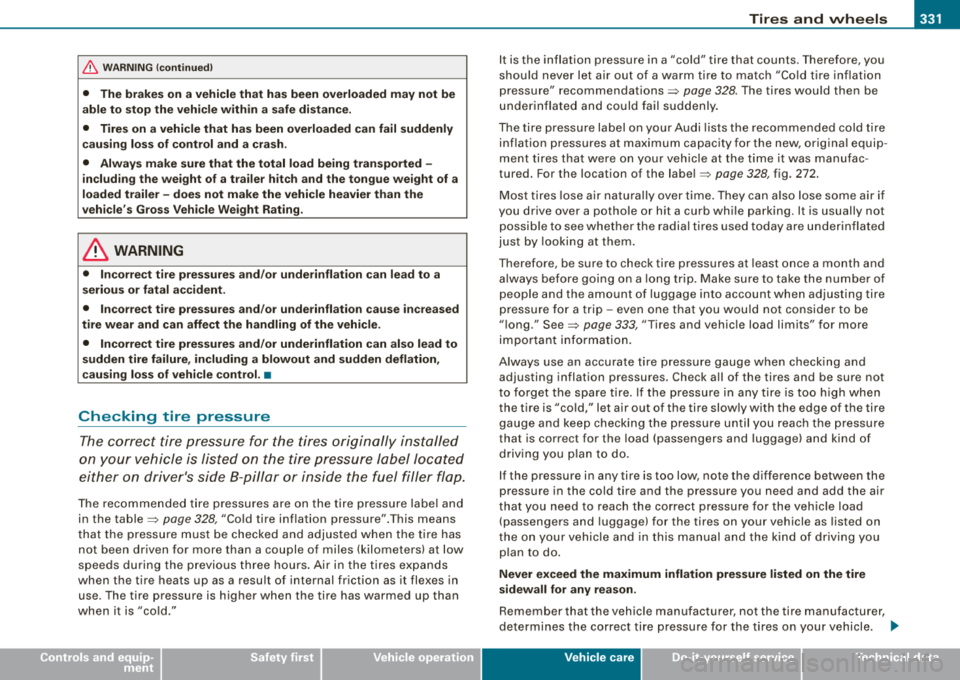
Tires and wheels Ill
----------------
•
& WARNING (continued )
• The brakes on a vehicle that has been overloaded may not be
able to stop the vehi cle within a safe distance .
• Tires on a vehicle that has been overloaded can fail suddenly
c au sing lo ss of control and a cra sh.
• Always make sure that the total load being transported -
including the we ight of a trailer hitch and the tongue weight of a
loaded trailer -does not make the vehicle heavier than the
v ehicle's Gross Vehicle Weight Rating .
& WARNING
• Incorrect tire pressures and /or underinflation can lead to a
serious or fatal accident.
• Incorre ct tire pressures and /or underinflation cause in creased
tire wear and can affect the handling of the vehicle .
• Incorrect tire pressures and /or underinflation can also lead to
sudden tire failure, including a blowout and sudden deflation,
c ausing loss of vehi cle control.
•
Checking tire pressure
The c orrect tire pressu re f or the tires ori gina lly installe d
on your vehicle is lis ted on the ti re pressure la bel loca ted
either on driver's side 8-pillar or inside the fuel filler flap.
The rec omme nded ti re p ressu res a re on the tire pr essure la be l an d
in the
table~ page 328, "Co ld tire inflation pressure". This means
t ha t th e pres su re m us t be c hecked a nd adjus ted w he n t he ti re has
not been driven for more than a couple of miles (kilometers) at low
speeds du rin g the p revio us th ree hou rs . Ai r in t he tires ex pand s
when the tire heats up as a resu lt of internal fr iction as it flexes in
use. The tire pressure is hig her when the tire has warmed up than
when it is "co ld ." I
t is the inflation pressure in a "cold" t ire that counts . Therefore, you
s h oul d never le t air ou t of a warm ti re to matc h "Co ld t ire in fl ati on
pressure"
recommendations~ pa ge 328 . The tires wou ld then be
u nde rinflate d and could fail sud denly .
The t ire pressure label o n your Au di lists the recomme nded cold t ire
inflation press ures at maximum capacity for the new, origina l equip
m ent tires t hat we re on yo ur vehicle at t he t ime it was manufac
tured. For the location of the
labe l~ page 328, fig . 272.
M ost tires lose a ir natu rally ove r ti m e. T hey can a lso lose so me air if
you drive ov er a pothole or h it a curb while parkin g. It is usually not
pos sible to see whe the r the rad ial tir es use d today are unde rin flated
just by look in g at t hem .
T herefore, be sure to chec k tire pressures at least once a month and
a lways be fore go ing o n a lo ng trip . Make su re to take the nu mber o f
people and the amount of luggage into account when ad justing tire
pr ess u re fo r a trip -even one t hat you wou ld not conside r to be
" long ."
See~ page 333, "Tires and vehic le load limits" for more
i mp ort ant i nfor mati on .
A lways use a n accu rate ti re p ressure gauge w hen c hec kin g a nd
adjusting inflation pressures . Chec k all of the tires and be sure not
t o fo rget t he spare t ire . If the pressu re i n an y tire is too high when
the tire is "co ld," let air out of the tire slow ly with the edge of the tire
ga uge and kee p checking the press ure u ntil y ou r each th e pr essu re
that is correct for the load (passengers and luggage) and kind of
d riv in g yo u plan to do .
I f the pressure in any tire is too low, note the difference between the
pressure in the cold tire and the pressure you need and add the air
t hat you need to r each the correct pressure for the veh ic le load
(passengers and luggage) for the tires on your vehicle as listed on
t he o n you r vehicl e and i n thi s m anua l a n d t he kind of driving yo u
p lan to do.
Never exceed the maximum inflation pressure listed on the tire
sidewall for any reason .
Remember that the vehic le manufacturer, not the tire manufacturer,
deter mines the correc t tire pressure for the ti res on your vehicle.
~
Vehicle care
Page 338 of 404
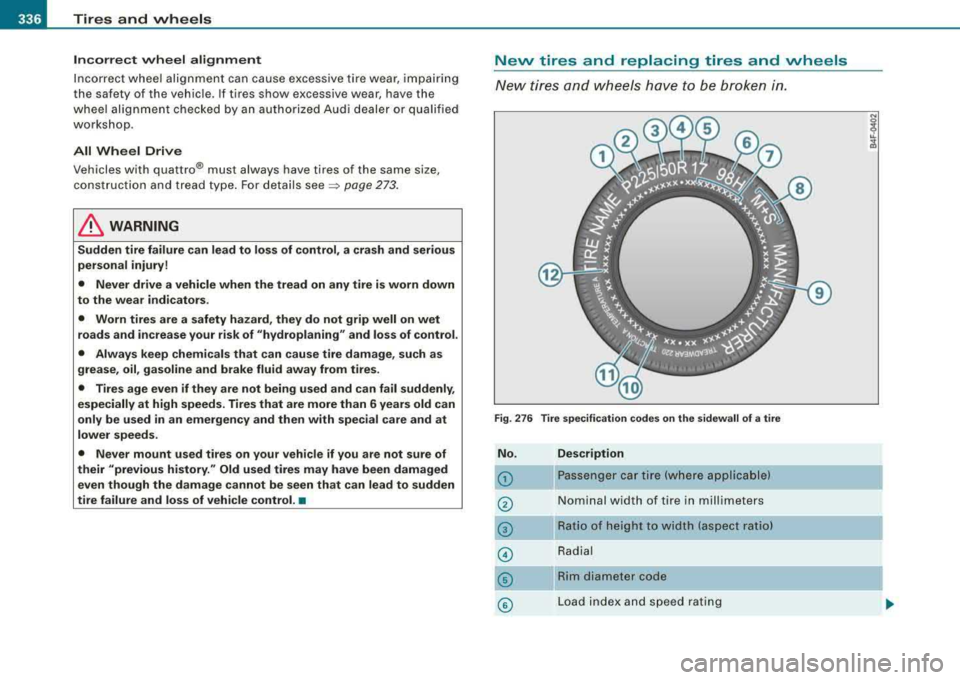
1119...__T_ ir_e _ s_ a_ n
_ d_ w_ h_ e_ e_ls _________________________________________________ _
Incorrect wheel alignment
Incorrect wheel alignment can cause excess ive tire wea r, impairi ng
the safety of the vehic le. If tires show excessive wear, have the
whee l alignment c hecked by an au th o rize d Audi deale r or qualifie d
wo rkshop.
All Wheel Drive
Vehicles with quattro® must always have tires of the same size, construc tion and tread type. F or details see
~ p age 273 .
& WARNING
Sudden tire failure can lead to los s of control, a crash and serious
personal injury !
• Never drive a vehicle when the tread on any tire is worn down
to the wear indi cators .
• Worn tires are a safety hazard, they do not grip well on wet
roads and increase your risk of "hydroplaning " and loss of control.
• Always keep chemicals that can cause tire damage , such as
grease, oil , gasoline and brake fluid aw ay from tires .
• Tires age even if they are not being used and can fail suddenly ,
especially at high speeds. Tires that are more than 6 years old can
only be used in an emergency and then with special care and at
lower speed s.
• Never mount used tires on your vehicle if you are not sure of
their "previous history." Old used tires may have been damaged
even though the damage cannot be seen that can lead to sudden
tire failure and los s of veh icle control. •
New tires and replacing tires and wheels
N ew t ires and wheels h ave t o be broke n in.
Fig . 2 76 T ir e specification code s on the sidewall of a tire
No .
G)
0
©
©
©
©
Description
Passenger car tire (where applicable)
Nominal width of tire in millimeters
Ratio of height to width (aspect ratio)
Radial
Rim diameter code
L o ad in dex and s peed rat ing
Page 341 of 404
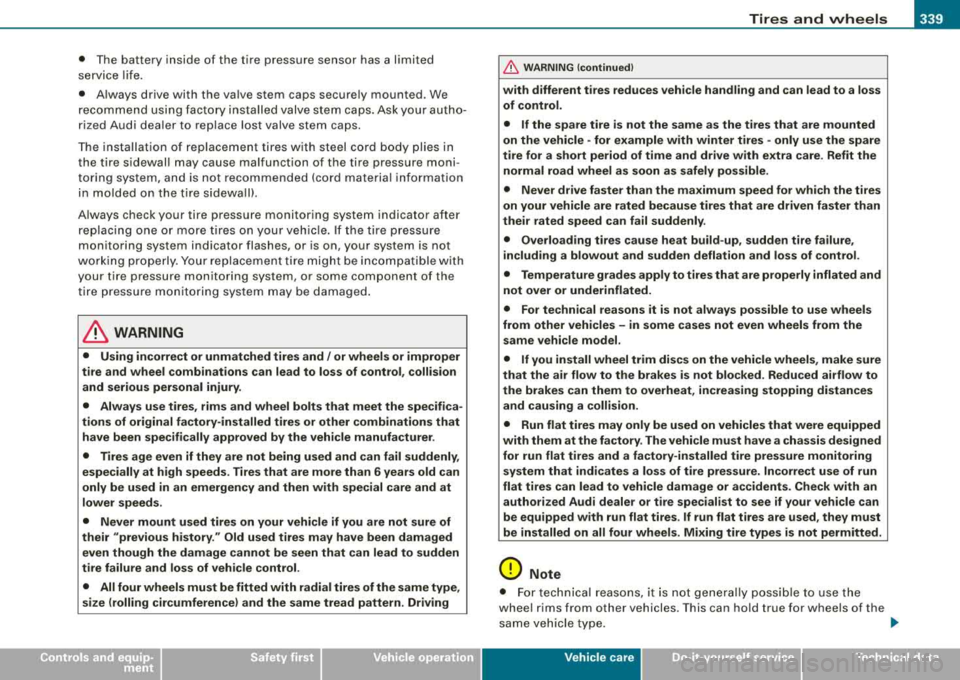
________________________________________________ T_ i
_ r_e _s_ a_n_ d_ w_ h_ e_e _ l_s __ l'III
•
• T he batt ery inside of the tire pressure sensor has a l imited
s er vice l ife.
• Al ways drive with the va lve stem ca ps sec ure ly m ounted. We
r ec om mend u sin g fa ctor y in sta lle d v alv e stem caps. Ask your autho
rized Audi d ealer to replac e lost valve stem caps .
T he in stalla tio n of replacement ti res with steel cord body plies i n
th e tire s id ewal l may cause malfunct ion of the tire pressure moni
toring sy ste m, and is not recommended (c ord mate ria l infor mation
i n mo lded on the tire s idewa ll).
Al ways check your tir e pressure monitor ing system indicator after
r eplac ing on e o r m ore tire s on y our vehi cle. If the tire pressu re
monitorin g system indicator flashes, or is on, your system is not
w orki ng pr ope rly. You r rep lace ment tir e mi ght be in co m pati ble w ith
your t ire pr essure monitoring system, or some component of the
t ir e pr ess ure m oni to ring sys te m m ay be damaged .
& WARNING
• Using incorrect or unmatched tires and / or wheels or improper
tire and wheel combinations can lead to loss of control , collision
and serious personal injury .
• Always use tires , rims and wheel bolts that meet the specifica
tions of original factory -installed tires or other combinations that
have been specifically approved by the vehi cle manufacturer .
• Tires age even if they are not being used and can fail suddenly,
espe cially at high speeds . Tires that are more than 6 years old can
only be used in an emergency and then with special care and at
lower speeds .
• Never mount used tires on your vehicle if you are not sure of
their "previous history ." Old used tires may have been damaged
even though the damage cannot be seen that can lead to sudden
tire failure and loss of vehicle control.
• All four wheels must be fitted with radial tires of the same type ,
size (rolling cir cumference ) and the same tread pattern . Driving
&, WARNING (continued )
with different tires reduces vehicle handling and can lead to a loss
of control.
• If the spare tire is not the same as the tires that are mounted
on the vehicle
-for example with winter tires -only use the spare
tire for a short period of time and drive with extra care . Refit the
normal road wheel as soon as safely possible.
• Never drive faster than the maximum speed for which the tires
on your vehicle are rated because tires that are driven faster than
their rated speed can fail suddenly.
• Overloading tires cause heat build -up , sudden tire failure,
including a blowout and sudden deflation and loss of control.
• Temperature grades apply to tires that are properly inflated and
not over or underinflated.
• For techni cal reasons it is not always possible to use wheels
from other vehicles -in some cases not even wheels from the
same vehicle model.
• If you install wheel trim discs on the vehicle wheels , make sure
that the air flow to the brakes is not blocked . Reduced airflow to
the brakes can them to overheat , increasing stopping distances
and causing a collision.
• Run flat tires may only be used on vehicles that were equipped
with them at the factory . The vehicle must have a chassis designed
for run flat tires and a factory-installed tire pressure monitoring
system that indicates a loss of tire pressure. Incorrect use of run
flat tires can lead to vehicle damage or accidents . Check with an
authorized Audi dealer or tire specialist to see if your vehicle can
be equipped with run flat tires . If run flat tires are used , they must
be installed on all four wheels . Mixing tire types is not permitted.
0 Note
• Fo r tec hnica l reaso ns, i t is not gene rally p oss ibl e to use the
whee l rims from other vehicles . T his can hold true for wheels of t he
sa me v ehicl e typ e.
Vehicle care
Page 353 of 404

What do I do now? Ill
------------------~;___
•
-Disengage and lower the floor panel before you close the
luggage compartment lid again.
Storing the replaced wheel
-Place the replaced wheel inside the spare wheel well in
the luggage compartment.
Tighten the knurled retaining screw clockwise to secure
the wheel in place.
-Disengage and lower the floor panel before you close the
luggage compartment lid again.
& WARNING
Loose items in the passenger compartment can cause serious
personal injury during hard braking or in an accident .
• Never store the spare wheel or jack and tools in the passenger
compartment.
• Always store all jacking equipment, tools, and the spare wheel
in the luggage compartment .
• Tighten the knurled retaining screw for the spare wheel
securely.
[ i] Tips
Check the inflation pressure of the spare tire periodically to keep the
tire ready for use. •
Changing a wheel
Before changing a wheel
Observe the following precautions for your own and your
passenger's safety when changing a wheel.
-After you experience a tire failure, pull the car well away
from moving traffic and try to reach level ground before
you stop
~ &,. .
-All passengers should leave the car and move to a safe
location (for instance, behind the
guardrail) ~&,. .
-Engage the parking brake to prevent your vehicle from
rolling
unintentionally ~&,. .
-Move selector lever to position P ~ &,..
-If you are towing a trailer: unhitch the trailer from your
vehicle.
-Take the jack and the spare tire out of the luggage
compartment~ page 349.
& WARNING
You or your passengers could be injured while changing a wheel if
you do not follow these safety precautions:
• If you have a flat tire, move a safe distance off the road. Turn off
the engine, turn the emergency flashers on and use other warning
devices to alert other motorists.
• Make sure that passengers wait in a safe place away from the
vehicle and well away from the road and traffic.
• To help prevent the vehicle from moving suddenly and possibly
slipping off the jack, always fully set the parking brake and block
the wheel diagonally opposite the wheel being changed. When one _..
Do -it -yourself service
Page 361 of 404
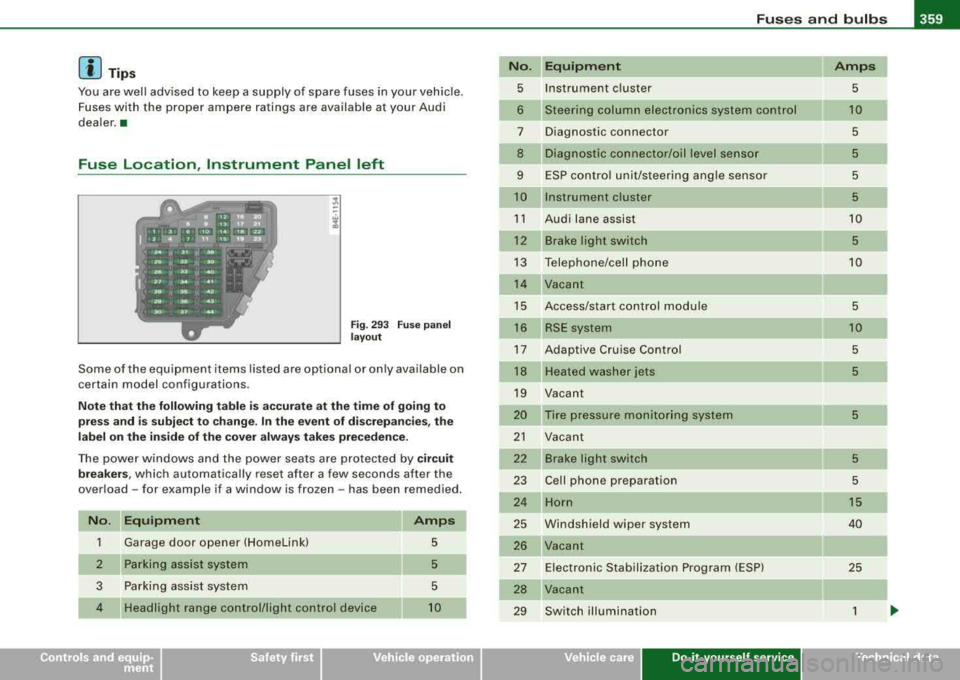
_________________________________________________ F_ u_ s_ e_s _ a_n _d_ b_ u
_ lb_ s _ __.11111
[ i J Tips
You are well advised to keep a supply of spare fuses in your vehicle.
Fuses with the proper ampere ratings are available at your Audi
dealer. •
Fuse Location , Instrument Panel left
Fig . 293 Fuse panel
layout
Some of the equipment items listed are optional or only available on
certain model configurations.
Note that the following table is accurate at the time of going to
press and is subject to change. In the event of discrepancies, the
label on the inside of the cover always takes precedence.
The power windows and the power seats are protected by circuit
breakers, which automatically reset after a few seconds after the
overload -for example if a window is frozen -has been remedied.
No. Equipment
1 Garage door opener (Homelinkl 5
2
Parking assist system 5
3
Parking assist system 5
4
Headlight range control/light control device 10
No.
5
6
7
8
9
10
11
12
13
14
15
16
17
18
19
20
21
22
23
24
25
26
27
28
29
Equipment Amps
Instrument cluster 5
Steering column electronics system control 10
Diagnostic connector 5
Diagnostic connector/oil level sensor 5
ESP control unit/steering angle sensor 5
Instrument cluster 5
Audi lane assist 10
Brake light switch 5
Telephone/cell phone 10
Vacant
Access/start control module
5
RSE system 10
Adaptive Cruise Control 5
Heated washer jets 5
Vacant
Tire pressure mon itoring system
5
Vacant
Brake light switch
5
Cell phone preparation 5
Horn 15
Windshield wiper system 40
Vacant Electronic Stabilization Program (ESP)
25
Vacant
Switch illumination
1
Vehicle care Do-it-yourself service irechnical data